
Concept explainers
(a)
Interpretation:
The product for the reaction between
Concept introduction:
The reaction in which one form of an ester is converted to another form by changing the carbon skeleton of the alkoxide part (OR) of the ester is called transesterification. The transesterification reaction is a nucleophilic addition-elimination reaction. In the first step, the nucleophile adds the electro-poor carbonyl carbon of the ester, which forces the bonding pair of carbonyl p bond onto the O atom. A negative charge is produced on that O, and a tetrahedral intermediate is formed. In the second step, tetrahedral intermediate undergoes nucleophilic elimination to form the transesterification product. The transesterification is a reversible reaction. The base hydrolysis of an ester to produce corresponding
Answer to Problem 20.28P
The product for the reaction between

The complete detailed, mechanism for the given reaction is
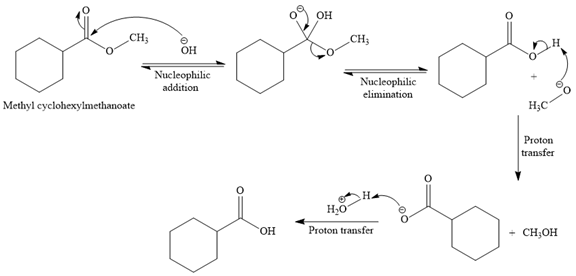
Explanation of Solution
The given reaction is
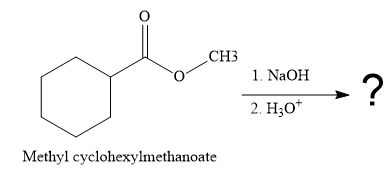
So this is a saponification reaction of

In the second step, nucleophilic elimination takes place to produce an alkoxide ion and corresponding carboxylic acid. These steps are reversible.

In the third step, irreversible deprotonation of the carboxylic acid takes place and the carboxylate ion is formed. Finally, on acid workup step, protonation of the carboxylate ion takes place to form the carboxylic acid.

Thus, the products of the given reaction are
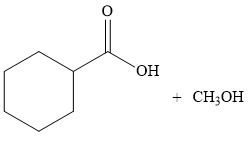
The product is predicted by using transesterification concept and the detailed mechanism is drawn.
(b)
Interpretation:
The product for the reaction between
Concept introduction:
The reaction in which one form of an ester is converted to another form by changing the carbon skeleton of the alkoxide part (OR) of the ester is called transesterification. The transesterification reaction is a nucleophilic addition-elimination reaction. In the first step, the nucleophile adds the electro-poor carbonyl carbon of the ester, which forces the bonding pair of carbonyl p bond onto the O atom. A negative charge is produced on that O, and a tetrahedral intermediate is formed. In the second step, tetrahedral intermediate undergoes nucleophilic elimination to form the transesterification product. The transesterification is a reversible reaction. The base hydrolysis of an ester to produce corresponding carboxylic acid and alcohol is called a saponification reaction.
Answer to Problem 20.28P
The product for the reaction between
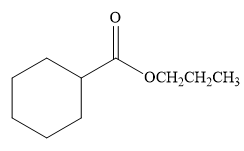
The complete detailed, mechanism for the given reaction is

Explanation of Solution
The given reaction is
This is a transesterification reaction of

In the second step, the tetrahedral intermediate undergoes nucleophilic elimination to form the transesterification product.

Thus, the product of the given reaction is

The product is predicted by using transesterification concept and the detailed mechanism is drawn.
(c)
Interpretation:
The product for the reaction between
Concept introduction:
The reaction in which one form of an ester is converted to another form by changing the carbon skeleton of the alkoxide part (OR) of the ester is called transesterification. The transesterification reaction is a nucleophilic addition-elimination reaction. In the first step, the nucleophile adds the electro-poor carbonyl carbon of the ester, which forces the bonding pair of carbonyl p bond onto the O atom. A negative charge is produced on that O, and a tetrahedral intermediate is formed. In the second step, tetrahedral intermediate undergoes nucleophilic elimination to form the transesterification product. The transesterification is a reversible reaction. The base hydrolysis of an ester to produce corresponding carboxylic acid and alcohol is called a saponification reaction.
Answer to Problem 20.28P
The product for the reaction between
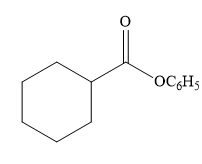
The complete detailed, mechanism for the given reaction is

Explanation of Solution
The given reaction is
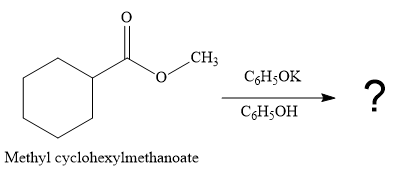
This is a transesterification reaction of the

In the second step, tetrahedral intermediate undergoes nucleophilic elimination to form the transesterification product.

Since phenoxide ion (
Thus, the product of the given reaction is

The product is predicted by using transesterification concept and the detailed mechanism is drawn.
Want to see more full solutions like this?
Chapter 20 Solutions
Organic Chemistry: Principles And Mechanisms
- One method for the analysis of Fe3+, which is used with a variety of sample matrices, is to form the highly colored Fe3+–thioglycolic acid complex. The complex absorbs strongly at 535 nm. Standardizing the method is accomplished using external standards. A 10.00-ppm Fe3+ working standard is prepared by transferring a 10-mL aliquot of a 100.0 ppm stock solution of Fe3+ to a 100-mL volumetric flask and diluting to volume. Calibration standards of 1.00, 2.00, 3.00, 4.00, and 5.00 ppm are prepared by transferring appropriate amounts of the 10.0 ppm working solution into separate 50-mL volumetric flasks, each of which contains 5 mL of thioglycolic acid, 2 mL of 20% w/v ammonium citrate, and 5 mL of 0.22 M NH3. After diluting to volume and mixing, the absorbances of the external standards are measured against an appropriate blank. Samples are prepared for analysis by taking a portion known to contain approximately 0.1 g of Fe3+, dissolving it in a minimum amount of HNO3, and diluting to…arrow_forwardAbsorbance and transmittance are related by: A = -log(T) A solution has a transmittance of 35% in a 1-cm-pathlength cell at a certain wavelength. Calculate the transmittance if you dilute 25.0 mL of the solution to 50.0 mL? (A = εbc) What is the transmittance of the original solution if the pathlength is increased to 10 cm?arrow_forwardUnder what conditions will Beer’s Law most likely NO LONGER be linear? When the absorbing species is very dilute. When the absorbing species participates in a concentration-dependent equilibrium. When the solution being studied contains a mixture of ions.arrow_forward
- Compared to incident (exciting) radiation, fluorescence emission will have a: Higher energy Higher frequency Longer wavelengtharrow_forwardLin and Brown described a quantitative method for methanol based on its effect on the visible spectrum of methylene blue. In the absence of methanol, methylene blue has two prominent absorption bands at 610 nm and 663 nm, which correspond to the monomer and the dimer, respectively. In the presence of methanol, the intensity of the dimer’s absorption band decreases, while that for the monomer increases. For concentrations of methanol between 0 and 30% v/v, the ratio of the two absorbance, A663/ A610, is a linear function of the amount of methanol. Use the following standardization data to determine the %v/v methanol in a sample if A610 is 0.75 and A663 is 1.07.arrow_forwardThe crystal field splitting energy, Δ, of a complex is determined to be 2.9 × 10-19 What wavelength of light would this complex absorb? What color of light is this? What color would the compound be in solution?arrow_forward
- A key component of a monochromator is the exit slit. As the exit slit is narrowed, the bandwidth of light (i.e., the range of wavelengths) exiting the slit gets smaller, leading to higher resolution. What is a possible disadvantage of narrowing the exit slit? (Hint: why might a narrower slit lower the sensitivity of the measurement?).arrow_forwardAn x-ray has a frequency of 3.33 × 1018 What is the wavelength of this light?arrow_forwardChoose the Lewis structure for the compound below: H2CCHOCH2CH(CH3)2 HH H :d H H H C. Η H H HH H H H H. H H H HH H H H H H- H H H C-H H H HHHHarrow_forward
- Each of the highlighted carbon atoms is connected to hydrogen atoms.arrow_forwardく Complete the reaction in the drawing area below by adding the major products to the right-hand side. If there won't be any products, because nothing will happen under these reaction conditions, check the box under the drawing area instead. Note: if the products contain one or more pairs of enantiomers, don't worry about drawing each enantiomer with dash and wedge bonds. Just draw one molecule to represent each pair of enantiomers, using line bonds at the chiral center. More... No reaction. Explanation Check O + G 1. Na O Me Click and drag to start drawing a structure. 2. H + 2025 McGraw Hill LLC. All Rights Reserved. Terms of Use | Privacy Center | Accessibility 000 Ar Parrow_forwardDraw a tetramer of this alternating copolymer.arrow_forward
